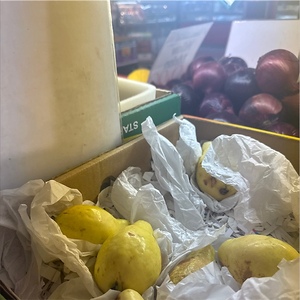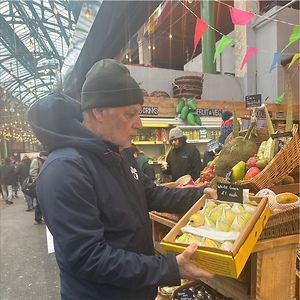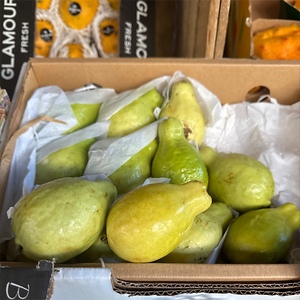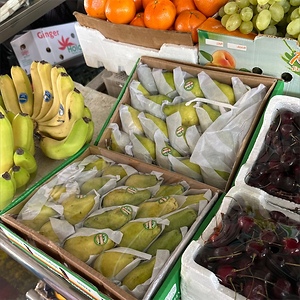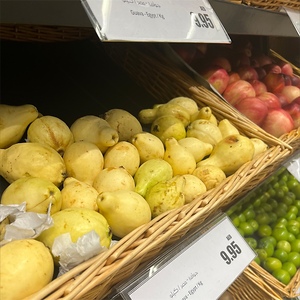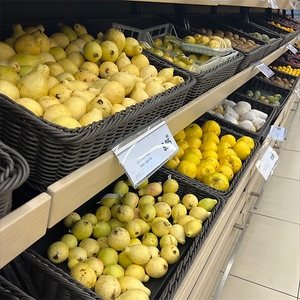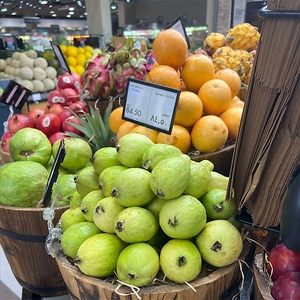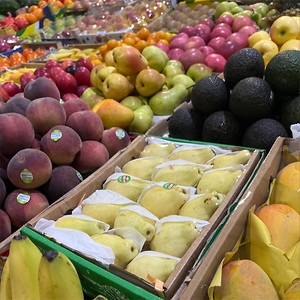


Egyptian Guavas
Estimated Inventory, lb : 0
Description/Taste
Egyptian guavas vary in size from small to large based on the specific variety and growing conditions, and the fruits average 7 to 12 centimeters in length. The fruits appear in oval to pyriform shapes with a bulbous base tapering to a slender, curved neck, and the skin is thin, delicate, and tender. The surface is generally smooth, sometimes featuring small bumps under the skin, and ripens from green to shades of yellow and white. Some Egyptian guava varieties develop a faint pink blush on surfaces exposed to ample sunlight during cultivation. Underneath the surface, the white flesh is thick and aqueous, becoming soft, tender, and succulent when ripe. The flesh also encases a central cavity filled with hard golden seeds. These seeds can be swallowed, but they should not be chewed. Some consumers choose to spit the seeds out when eating. Egyptian guavas are edible raw and release an aromatic, musky odor when ripe. The flesh has a mild, sweet, floral, and subtly fruity taste with subtly tangy and tart nuances.
Seasons/Availability
Egyptian guavas are harvested in the late summer through late spring.
Current Facts
Egyptian guavas, botanically classified as Psidium guajava, are a category of commercial guava varieties grown in Egypt, belonging to the Myrtaceae family. There are three main varieties sold under the general Egyptian guava name, known as Bassateen El Sabahia, Bassateen Edfina, and Allahabad Safeda. Egyptian guavas generally grow on trees reaching 4 to 6 meters in height and ripen approximately 60 to 90 days after flowering. Growers favor Egyptian guavas for their high yields, fragrant nature, and sweet-tart taste. Egyptian guavas are standard commercial fruits grown throughout Egypt, and the fruits are regarded as table fruit, consumed mainly for fresh purposes. Egyptian guavas are hand-picked when harvested for fresh sale to protect their thin, delicate skin. The fruits are also mechanically harvested on a smaller scale and sold for processing into juices and pastes. Egyptian guavas are notably known for their bright white pulp, a desired trait in processed preparations.
Nutritional Value
Egyptian guavas are a source of fiber to regulate the digestive tract, potassium to balance fluid levels within the body, and vitamin C to boost the immune system. Like other guava varieties, in general, the fruits provide some calcium to build strong bones and teeth, phosphorus to repair tissues, magnesium to control nerve functions, vitamin A to maintain healthy organs, iron to develop the protein hemoglobin for oxygen transport through the bloodstream, and other nutrients, including folate, copper, vitamin E, and manganese.
Applications
Egyptian guavas have a sweet, floral flavor suited for fresh and cooked preparations. The fruits are edible raw, and the skin does not have to be peeled before consumption. Egyptian guavas are served out of hand as a ripe snack or chopped half-ripe and coated in a mixture of sugar, salt, chili powder, and other spices. This preparation is a popular street food, and it is served as a bite-sized dish when hosting house guests. Egyptian guavas can also be mixed into fruit salads, used as a fresh topping over breakfast dishes, or incorporated into iced desserts. The fruits are popularly pureed with honey, lime, and orange juice and then sprinkled with pomegranate seeds and torn mint as a refreshing dish. Egyptian guavas are also pickled as a condiment or added to puddings, custards, and jellies. In the Middle East, Egyptian guavas are a favored variety for beverages. The fruits are blended or pressed into juicers and combined with water, milk, and sugar. The juice is also added to cocktails and smoothies. In addition to beverages, Egyptian guavas are cooked into jams, jellies, or pastes and served as an accompaniment to various cheeses on appetizer platters. Egyptian guavas pair well with fruits such as strawberries, cantaloupe, pineapples, and oranges, herbs including mint, basil, and cilantro, honey, sugar, vanilla extract, and cheeses such as cheddar, brie, and gouda. Whole, unwashed Egyptian guavas should be ripened at room temperature in a cool, dry, and dark place. Once ripe, they should be immediately consumed for the best quality and flavor and can be wrapped in plastic in the refrigerator for around one week.
Ethnic/Cultural Info
Egyptian guavas are a popular ingredient for homemade shampoos and hair care products in Egypt. While the fruits are a recent introduction into modern-day products, they are revered for their aromatic, fruity, floral, and musky fragrance. Hair care products have been used among Egyptian civilizations since ancient times, and it was common for the scalp and head to be covered in castor oil, olive oil, flowers, or animal fats. Historically, hair and scalp products were called “schema” in Egypt before the creation of the word shampoo, and these products had varying purposes, from cleansing the scalp, protecting it from the sun, increasing hair growth, and reducing dandruff. Over time, the word “shampoo” was derived from the Hindi word “champo,” roughly meaning “to press or massage,” and cleansing hair care products were later released under this name as a commercial beauty item.
Geography/History
Guavas are native to the Americas and were carried by Portuguese and Spanish explorers to regions in Asia sometime during the 15th and 16th centuries. As the species naturalized and spread along trade routes, it was planted in India and quickly took root in the regions with tropical to subtropical climates. Experts believe guavas may have been transported to Egypt through India around the 1830s, and since their introduction, the species has become a widespread commercial fruit. Egyptian guavas were bred over time to create improved cultivars suited for the country’s growing environment, and a variety known as Bassateen El Sabahia became one of the most popular cultivars for commercial production. This variety was later selectively bred, and over 300 seedlings were evaluated before a new cultivar was chosen under the name Bassateen Edfina in 1975. Today, Egyptian guavas are commercially grown in the Lower, Middle, and Upper regions. In Upper Egypt, the fruits are cultivated in the Dakhla Oasis, while in Middle Egypt, the fruits are planted in Cairo. Egyptian guavas are notably produced in Alexandria in Lower Egypt, and this region is thought to have the highest annual output. Egyptian guavas are sold domestically and are also exported to Europe, the Middle East, and India. In Europe, the fruits are sold to Spain, Germany, France, Greece, Belgium, and the Netherlands, with Belgium and the Netherlands re-exporting the fruits to other European countries. Egyptian guava seeds are also sold through online seed retailers as a specialty variety for cultivation in home gardens worldwide. The Egyptian guavas featured in the photograph above were sourced through the Waterfront Market in Dubai.



